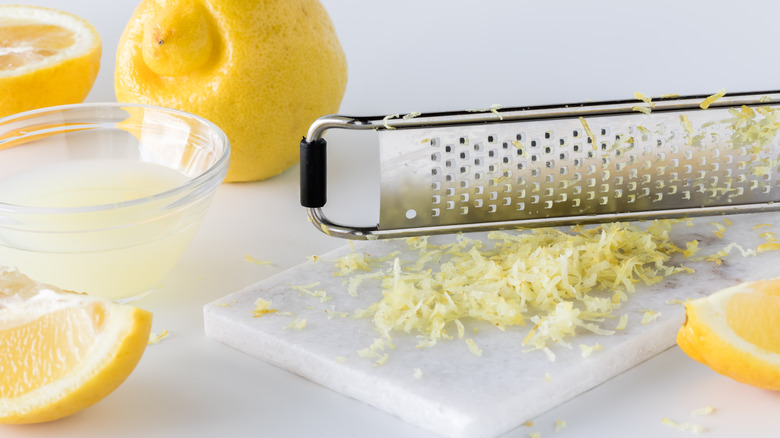How To Hold A Microplane For The Easiest Zesting
Experiencing the delicious, aromatic difference citrus zest brings to dishes and drinks can inspire you to raise your home-cooking game through zesting. However, this kitchen task looks deceptively simple. The wrong technique for handling a microplane can result in over-zesting the fruit, which happens when you zest too deeply into the peel that you reach the pith beneath. Aside from the unpleasant inclusion of the pith's bitterness in a dish, over-zesting doesn't maximize the zest you can get from the fruit. Improper handling of a kitchen tool also leaves you vulnerable to accidents.
The good news is chef Joshua Weissman shared online his technique of holding a microplane for hassle-free zesting. In his demonstration, instead of keeping his grip on the tool's handle, Weissman grabbed it in the middle, right over its metal part. "Don't worry, it's not going to hurt you," he reassured viewers. He then unfurled his thumb so he could place it firmly against the lemon that he held in his other hand. According to him, this would help rotate the fruit so its peel would get equal zesting. With the microplane placed flush against the top of the lemon, the chef began to zest by moving his elbows up and down. Each downward motion of his elbows provided the force and momentum that allowed the tool's blades to grate the peel in a clean strip. Meanwhile, the hand holding the fruit gradually rotated it between strips until it was zested all the way around.
A proper technique maximizes the zest you get from a citrus
While Weissman acknowledged that there's nothing inherently wrong with zesting a citrus fruit by placing it on top of a microplane and lightly grating it, he pointed out how this leaves the fruit peel with unevenly zested spots. Given the amount of fragrant oils that zest can impart to a dish or a drink to elevate its flavor, not being able to maximize the amount offered by a citrus fruit is a waste. With Weissman's technique, you get the most zest that you can while still leaving your lemons, limes, and oranges perfectly usable for other kitchen needs. It also prevents you from pressing the microplane too hard against the fruit, which can gradually flatten its blades and make them duller.
Speaking of dull blades, proper technique is just one part of the equation. Keeping your microplane's blades clean and sharp is also crucial. To sharpen them, hold the tool at a 30-degree angle against a sharpening stone and move it back and forth with light strokes. Adjust the angle as you sharpen the entire surface. Remember to wear protective gloves too as you do this. Afterward, wash your microplane with soap and water and dry it completely before storing it. As for cleaning it post-zesting, use a sponge to scrub the dull backside of its grater to remove any stuck bits of food or peel.

